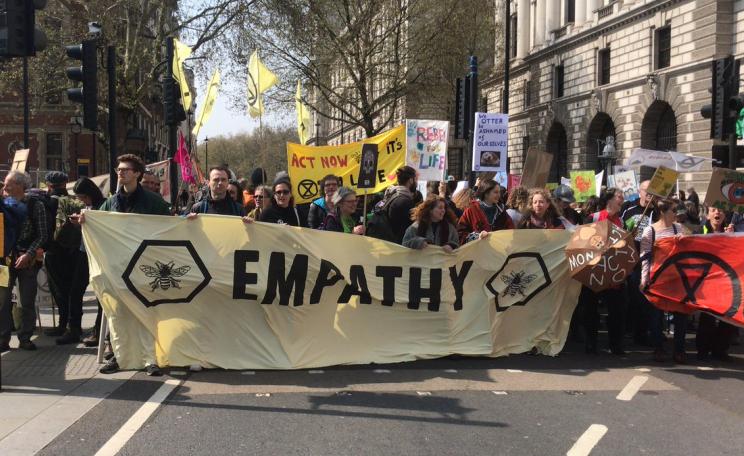-
Environmental protestors came up with a range of different tactics at the Extinction Rebellion demonstrations last year.
Activists were creative in their attempts to attract attention and evade the police, from a giant pink octopus to scaling Big Ben. But the most effective tool in their arsenal was a simple wooden box.
The weekend before the Extinction Rebellion protests in Autumn, police used a battering ram to break down the doors of an old courthouse in Lambeth. Ten Extinction Rebellion activists were arrested and equipment for a fortnight of planned protests including solar panels, batteries, toilets and gazebos were confiscated.
Over the next few days, vehicles coming into central London were searched and police made preemptive arrests for conspiring to cause a public nuisance. The message was clear, This time we won’t allow you to walk straight in.
Strategic construction
Monday morning, just before midday, two men disguised as undertakers drove a Hearse across the entrance to Trafalgar Square roundabout from Whitehall.
As he parked, the driver locked his neck to the steering wheel with a D-lock and activists chained themselves to the tyres of the car. From the surrounding streets, activists began to stream past unwitting police, carrying plywood boxes measuring 12 x 12 x 24 inches.
A small sculpture was built by bolting the boxes together, in the road behind the Hearse. Then as the number of boxes grew to hundreds, a stage 1.5m tall was erected under Nelson’s column.
Earlier in the day rumours had circulated that the boxes had come from the University of Arts London XR group. In fact, designs for the boxes were gifted to XR Hackney by the architectural practice Studio Bark.
XR adapted Studio Bark’s patterns by adding carry-holes to the designs. As well as making them easier to carry, activists could use the holes to install metal “lock-ons” (bulky arm-tubes which police must cut through to remove protestors).
The boxes are designed to create a dilemma for police trying to safely remove protestors. Nick Newman, an XR activist, explained: “If you have a box which has a lock-on tube built into it, you can’t cut into the box because you would jeopardise the structural integrity of the box on top”.
Collaborative
The agility of the boxes was no clearer than in their instrumentation four days later. On Friday morning, after edging up Whitehall, it was apparent the police were going to try and clear Trafalgar Square roundabout and push protestors onto the pavement.
In the ensuing chaos, police were accused of dragging tents off the road before checking they were empty, and confiscating personal possessions without fair warning.
In response, activists dismantled the two stages and built five towers on the road, some as tall as five metres, with lock-ons installed at strategic points in their construction. A standoff lasted most of the day, with police eventually bringing in a JCB to remove protestors later that night.
Since the protests, the boxes have been the subject of in-talk in architectural circles. Mr Newman was among those arrested that day on a tower five metres in height.
“It’s being called an ‘Architecture of Protest’”, he says from his Hackney studio. In total, 600 boxes - each costing £7.50 to make from sustainable materials - were made for this round of protests, all but 50 of which Mr Newman believes are now in police custody.
Now he is helping XR raise money to fund more boxes and hopes it inspires similar innovations for future protests. He said: “What’s exciting about this project is it wasn’t just a crowd-funded structure, it was a crowd-assembled structure. It’s taking collaborative architecture to a whole new level”.
This Author
Joe Goodman is a freelance journalist interested in data and the environment. He has written for the Guardian, Huffington Post, Vice and Dazed. Follow on Twitter @joegoodman94.
Image: Natasa Leoni.




